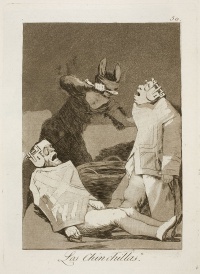Los caprichos
From The Art and Popular Culture Encyclopedia


|
Related e |
|
Featured: |
Caprichos is a set of 80 aquatint prints created by the Spanish master-painter Francisco Goya during the 1790s; among the most famous prints is "The Sleep of Reason Produces Monsters".
The prints were Goya's artistic experiment: a medium for his condemnation of the universal follies and foolishness in the Spanish society in which he lived. The criticisms are far-ranging and acid; he speaks against the predominance of superstition, the ignorance and inabilities of the various members of the ruling class, pedagogical short-comings, marital mistakes, and the decline of rationality - among other things.
Goya described the series as depicting "the innumerable foibles and follies to be found in any civilized society, and from the common prejudices and deceitful practices which custom, ignorance, or self-interest have made usual".
The work was an enlightened, visual tour-de-force critique of 18th century Spain, and humanity in general. The informal style, as well as the depiction of contemporary society found in Caprichos, makes them – and Goya himself – a precursor to the modernist movement almost a century later.
Caprichos were withdrawn from public sale before their planned release in 1799. Only a formal order from King Carlos IV kept Goya from being called before the Spanish Inquisition.
Francisco Goya was considered skilled but unremarkable until he contracted lead poisoning in his late forties and made Caprichos.
Goya's series, and the last group of prints in his series The Disasters of War, which he called "caprichos enfáticos" ("emphatic caprices"), are far from the spirit of light-hearted fantasy the term "caprice" usually suggests in art.
List of Spanish titles of the prints[1]
- Capricho nº 1: Francisco Goya y Lucientes, Pintor
- Capricho nº 2: El sí pronuncian y la mano alargan al primero que llega
- Capricho nº 3: Que viene el coco
- Capricho nº 4: El de la rollona
- Capricho nº 5: Tal para cual
- Capricho nº 6: Nadie se conoce
- Capricho nº 7: Ni así la distingue
- Capricho nº 8: ¡Que se la llevaron!
- Capricho nº 9: Tántalo
- Capricho nº 10: El amor y la muerte
- Capricho nº 11: Muchachos al avío
- Capricho nº 12: A caza de dientes
- Capricho nº 13: Están calientes
- Capricho nº 14: ¡Qué sacrificio!
- Capricho nº 15: Bellos consejos
- Capricho nº 16: Dios la perdone. y era su madre
- Capricho nº 17: Bien tirada está
- Capricho nº 18: Y se le quema la casa
- Capricho nº 19: Todos caerán
- Capricho nº 20: Ya van desplumados
- Capricho nº 21: ¡Cual la descañonan!
- Capricho nº 22: ¡Pobrecitas!
- Capricho nº 23: Aquellos polvos
- Capricho nº 24: No hubo remedio
- Capricho nº 25: Si quebró el cántaro
- Capricho nº 26: Ya tienen asiento
- Capricho nº 27: ¿Quién más rendido?
- Capricho nº 28: Chitón
- Capricho nº 29: Esto sí que es leer
- Capricho nº 30: ¿Por qué esconderlos?
- Capricho nº 31: Ruega por ella
- Capricho nº 32: Porque fue sensible
- Capricho nº 33: Al conde Palatino
- Capricho nº 34: Las rinde el sueño
- Capricho nº 35: Le descañona
- Capricho nº 36: Mala noche
- Capricho nº 37: ¿Si sabra más el discípulo?
- Capricho nº 38: ¡Bravísimo!
- Capricho nº 39: Hasta su abuelo
- Capricho nº 40: ¿De qué mal morirá?
- Capricho nº 41: Ni más ni menos
- Capricho nº 42: Tú que no puedes
- Capricho nº 43: El sueño de la razón produce monstruos
- Capricho nº 44: Hilan delgado
- Capricho nº 45: Mucho hay que chupar
- Capricho nº 46: Corrección
- Capricho nº 47: Obsequio al maestro
- Capricho nº 48: Soplones
- Capricho nº 49: Duendecitos
- Capricho nº 50: Los Chinchillas
- Capricho nº 51: Se repulen
- Capricho nº 52: ¡Lo que puede un sastre!
- Capricho nº 53: ¡Que pico de oro!
- Capricho nº 54: El vergonzoso
- Capricho nº 55: Hasta la muerte
- Capricho nº 56: Subir y bajar
- Capricho nº 57: La filiación
- Capricho nº 58: Trágala perro
- Capricho nº 59: ¡Y aún no se van!
- Capricho nº 60: Ensayos
- Capricho nº 61: Volavérunt
- Capricho nº 62: ¡Quién lo creyera!
- Capricho nº 63: ¡Miren que graves!
- Capricho nº 64: Buen viaje
- Capricho nº 65: ¿Dónde va mamá?
- Capricho nº 66: Allá va eso
- Capricho nº 67: Aguarda que te unten
- Capricho nº 68: Linda maestra
- Capricho nº 69: Sopla
- Capricho nº 70: Devota profesión
- Capricho nº 71: Si amanece, nos vamos
- Capricho nº 72: No te escaparás
- Capricho nº 73: Mejor es holgar
- Capricho nº 74: No grites, tonta
- Capricho nº 75: ¿No hay quién nos desate?
- Capricho nº 76: Está vuestra merced... pues, como digo... ¡eh! ¡cuidado! si no...
- Capricho nº 77: Unos a otros
- Capricho nº 78: Despacha, que despiertan
- Capricho nº 79: Nadie nos ha visto
- Capricho nº 80: Ya es hora
See also

_is_a_plate_10_from_Los_Caprichos_by_Francisco_Goya..jpg)

